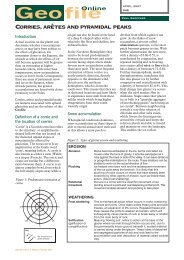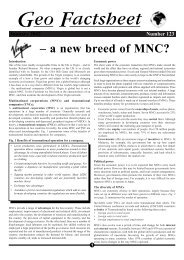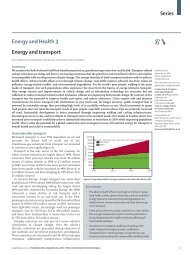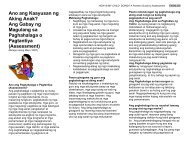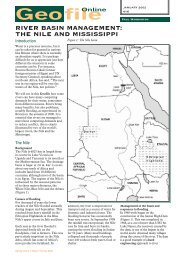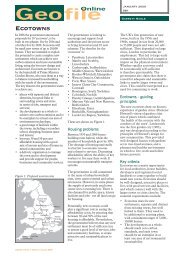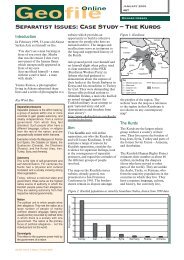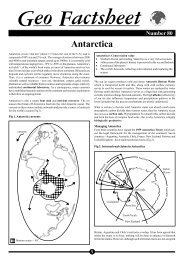reimaging settlements.pdf - Richmond School District No. 38
reimaging settlements.pdf - Richmond School District No. 38
reimaging settlements.pdf - Richmond School District No. 38
Create successful ePaper yourself
Turn your PDF publications into a flip-book with our unique Google optimized e-Paper software.
April 2010 no.619 Reimaging <strong>settlements</strong><br />
Figure 4: Testing the success of <strong>reimaging</strong><br />
Qualitative techniques<br />
Quantitative techniques<br />
generating statistical data<br />
Primary fieldwork<br />
Place check<br />
• Quality of built environment<br />
• Perception of new image<br />
Photographic/video evidence<br />
• Attractive and successful<br />
neighbourhoods<br />
Blog sites<br />
Egan wheel of sustainability<br />
Land use surveys<br />
Environmental quality surveys<br />
Crime and design surveys<br />
Interviews and questionnaires<br />
• Sense of pride<br />
• Fear of crime<br />
Pedestrian footfalls and traffic flows<br />
• Popular or deserted<br />
Secondary data collection<br />
Local newspapers<br />
• Evidence of poor health<br />
• Evidence of crime<br />
• Prestige cultural & sporting events<br />
Developers’ websites<br />
• Have the aims been met<br />
• Does the reality match the hype<br />
Census data<br />
• More and better jobs<br />
• A growing population<br />
<strong>School</strong> league tables<br />
• Better educated population<br />
Shop occupancy figures<br />
• Increasing retail function<br />
(flagship stores)<br />
GIS(geographical information systems)<br />
• Identify services and their distribution<br />
• Digitised health and crime maps<br />
How can the success of<br />
<strong>reimaging</strong> be measured<br />
Measuring the success of <strong>reimaging</strong><br />
can be seen as a cycle (Figure 2).<br />
Figure 5: Liverpool’s new image: high quality retail alongside the refurbished docks,<br />
home to cultural and heritage attractions building on the Liverpool story<br />
Often it is not exciting new<br />
architecture or large-scale<br />
developments which are important<br />
longer term, but the basics of mixed<br />
land uses, ease of movement, more<br />
opportunities, a clean environment,<br />
and safety day and night to work,<br />
live and relax (Figure 3).<br />
Some popular, well-tested research<br />
methods of testing this model are<br />
shown in Figure 4.<br />
Some unusual research sources may<br />
indicate the importance of image to<br />
a city, for instance celebrity Jeremy<br />
Clarkson’s one-word associations:<br />
• Paris-love<br />
• New York-shopping<br />
• London-the Queen<br />
• Sydney-the Bridge<br />
• Venice-canals<br />
• Johannesburg-crime<br />
The following case studies show<br />
a range of urban areas trying to<br />
reimage using a variety of catalysts.<br />
Case study 1: Liverpool<br />
– <strong>reimaging</strong> cataly<br />
Liverpool’s image in the early<br />
1980s was dominated by the<br />
decline of its 19th century<br />
industrial base. Unemployment<br />
had doubled between 1971 and<br />
1981 to 20.4%. Between 1971 and<br />
2001 its population fell by 27.9%;<br />
by 1991, 40% lived in poverty and<br />
Photographs by Rob Morris, Shrewsbury <strong>School</strong><br />
15% in intense poverty, twice the<br />
national levels. Derelict, often<br />
vacant and functionally obsolete<br />
industrial buildings characterised<br />
much of the inner city. These were<br />
interspersed with substandard<br />
traditional terraced housing and<br />
the controversial 1960s social<br />
experiments of high-rise estates.<br />
Key players, including Liverpool<br />
City Council, the <strong>No</strong>rth West<br />
Development Agency and the<br />
European Regional Development<br />
Fund, set out to reimage and<br />
support regeneration in the city<br />
through the Liverpool Vision<br />
Urban Regeneration Company.<br />
Over £2 billion from the public and<br />
private sectors has been invested<br />
in revitalising the city centre.<br />
Flagships include: Liverpool One<br />
retail and office development<br />
(Figure 5), a £15 million new Cruise<br />
Liner Terminal, the £150 million<br />
Echo Arena, Kings Waterfront,<br />
the Museum of Liverpool,<br />
major residential renewal and<br />
refurbishment in Kensington,<br />
Geofile Online © Nelson Thornes 2010



